Psychedelics In Medicine
Are you feeling it? We're taking a hallucinatory trip into the world of psychedelic drugs. These substances are going through a medical renaissance - we’ll learn how they work and how they might help to treat even the most serious psychiatric disorders. Plus, why an eye of fire appeared in the ocean off the coast of Mexico; astronomers pin down the birth of the first ever stars; and how some COVID tests can be tricked with orange juice!
In this episode

01:02 - UK COVID hospitalisations double every 9 days
UK COVID hospitalisations double every 9 days
Duncan Robertson, Loughborough University
This week Prime Minister Boris Johnson confirmed that the 19th July will see the country opening up - with the removal of any remaining restrictions on how we socialise, spend leisure time, or work. And despite climbing numbers of cases, policymakers have justified the easing of controls by pointing out that hospital admissions and deaths remain, thankfully, low. But when Chris Smith spoke to Loughborough University disease modeller Duncan Robertson, he pointed out that when considering the numbers of cases…
Duncan - We're seeing doubling around every nine days. The problem with that of course, is that we're still getting this link to hospitalisations. Hospitalisations are doubling at around the same rate.
Chris - How does that compare with what was going on in, say, January and last autumn, October, November, and indeed last April?
Duncan - With January, we had the alpha variant. Rates started to increase very quickly, but there was virtually no vaccination in the population then. What we're seeing now, is we're seeing most cases actually happening in the unvaccinated. And of course the unvaccinated are children and young people. But we're starting to see it creep up into the twenty-somethings, thirty-somethings, forty-somethings. And this is what has happened in the past with cases; they start in young people who are mixing and then move up the age ranges.
Chris - But is that a valid comparison? The past with the present? Because obviously the past where no one was vaccinated, we didn't have that protection, which we think is pretty good conferred by vaccination that we do now in those older people.
Duncan - Absolutely right. Vaccination has made a significant difference in terms of how much they go up those age ranges and how fast they go up those age ranges. But they're still going up those age ranges because it's not as though you reach 40 or 50 and everybody's had a vaccination. So still, if you look at the latest figures we have about 9 out of 10 people who have antibodies. Some people in their fifties, sixties, seventies, eighties, and above, haven't had a vaccination or haven't had a second vaccination. And of course with this Delta variant, more protection is after that second vaccination.
Chris - If we look though at where we are in terms of the number of people who are in hospital compared with previous outbreaks, we've got about between 1 and 2% of all of the beds in the NHS currently being used to treat people with coronavirus. Historically, we were getting up to the forties and fifties of percent. So it's hard to argue this time that we're putting the NHS under pressure.
Duncan - So this really comes down to what we think about whether the health system can cope. And I think various people have said that the health service will always cope. Essentially, you have lots of COVID cases that may come in and they will always be treated, but of course you get this difference between, should you treat a COVID patient or should you treat a non-COVID patient? And that's when you start having these trade-offs and difficult decisions have to be made. And really it's up to your definition about whether the NHS copes in those situations.
Chris - I was talking to some senior managers at one of the UK's leading hospitals today, and they told me that they're seeing quite a turnaround in terms of the type of person who they're now caring for with coronavirus compared with previously. They're seeing people who tend to be less ill and stay in hospital for less long. And so they think that actually we should be more optimistic.
Duncan - Absolutely. On average, we're seeing length of stay decrease since last waves. But the significant thing is what happens to the number of people in hospital. And even though the average stay may be being below, we still have people who are long stays, people in intensive care. So as well as looking at the rate of people coming into hospital, we have also had to look at the number of people in hospital. The numbers are really increasing on both, and if you get exponential growth or doubling of people coming into a hospital, then that poses a significant problem for the number of people in hospital.
Chris - Yeah, sure, but I think it can grow exponentially, but it doesn't mean it grows exponentially to a point where it compromises care. It certainly has done in the past, but the numbers are much lower now. We've got, say 20-30 people who are passing away compared to, in one case, 1500 people in a day earlier in the year.
Duncan - The problem is we're still seeing a link between the rate of cases increasing and the rates of hospitalisations increasing. So even though we may have very low levels, it only takes a few doublings for that to become very significant and really that link between cases and hospitalisations hasn't been broken. So if you allow more and more doublings of cases, you're going to allow more and more doublings of hospitalisations.

06:10 - Ocean 'on fire' twice in three days
Ocean 'on fire' twice in three days
Mark Tingay, University of Adelaide
Last week, the ocean caught fire. Twice. That’s not something you can say everyday. Firstly, the Gulf of Mexico hosted a glowing ‘eye of fire’ not far from an offshore oil rig; then, just two days later and on the opposite side of the world, a massive fireball erupted from the Caspian Sea, creating a column of fire that could easily be seen from 45 miles away. Sally Le Page spoke to geologist Mark Tingay from the University of Adelaide to find out what actually happened…
Mark - There was a leak in a gas pipeline near one of the major oil and gas fields in the Gulf of Mexico. That causes a lot of gas, obviously, to leak out of the pipeline, and lightning ignited that bubbling gas and caused the big eye of flame that we all saw on social media.
Sally - It did look incredibly dramatic. It didn't even look real to be perfectly honest with you.
Mark - It was incredible. And yeah, it is something that unfortunately we do see occur whenever we have a major fire associated with a major hydrocarbon leak in oil and gas fields.
Sally - How can an ocean catch fire? It's surrounded by water, water puts out fire, doesn't it?
Mark - Yeah, that's what you'd think isn't it? The water should put out a fire. In reality, it's not the water that's on fire, it is just the gas. So all the bubbles of gas, all the methane, natural gas, that's coming out of the ground, bubbles up through the water. And then once it gets to the surface, it's essentially feeding that fire. But the water itself actually isn't on fire. It just looks like it.
Sally - The images from that were, for me, it seemed like a kind of once in a lifetime sort of image, but then it happened again! We had a second fire in the oceans, this time in the Caspian Sea. What happened there was it the same deal?
Mark - The fire in the Gulf of Mexico was a broken gas pipeline near an oil platform. The fire in the Caspian Sea was actually a perfectly natural event where we had a big fireball that jetted out from the eruption of a major mud volcano on a very small island in the Caspian sea.
Sally - Wow. I've never even heard of a mud volcano before. What is a mud volcano?
Mark - So a mud volcano is a part of the Earth where subsurface water and mud essentially come out of the ground. So if you think about a volcano, a normal volcano, those erupt molten rock and ash. A mud volcano is a bit like that, but it erupts watery mud. And along with it, it can also erupt a lot of gas.
Sally - How big are they? Do they look like the mountains that we think of when we think of a volcano?
Mark - Most of them in the world are very small things that might only be tens of metres in size. The ones in Azerbaijan are quite unusual in that they do look like real volcanoes. They can be hundreds of meters tall.
Sally - So you've got this liquid mud, you've got these bubbles of natural gas erupting. What then sets that off to create what was such a dramatic mushroom cloud going into the sky of fire?
Mark - We're not a hundred percent sure because of course it's not something that we can easily test, but there's two main ideas. One is that it's just a very sharp drop in pressure. There's been a lot of simulation that suggests that just the very sharp drop in pressure could be enough to ignite the gas on its own. But I think another possibly quite likely situation is that when you've got all this very violent eruption of mud, it's not just water and clay. It's got boulders inside; rocks, cobbles, big chunks that can be half the size of a car. And these are things that are being violently thrown into the air. And of course they can bang together and potentially cause a spark. And you really just need one spark to ignite that huge amount of gas.
Sally - So this is the natural equivalent of striking two flints together.
Mark - That's right. Yes.
Sally - What are the environmental consequences of these fires happening in these oceans?
Mark - It's a good question, and I'm not exactly sure what the consequences are going to be of, for example, the Pemex fire. If it's mostly gas, then most of the gas would have burnt. And so your biggest issue there is of course, the emissions and its contribution to climate change. The real concern would have been how much gas might've been dissolved in the seawater. And if there was any oil that also was released, which of course we know from oil spills can cause huge devastation over a large area. Pemex has denied that there was any environmental damage or major oil spill. From mud volcanoes, of course, it's a natural phenomenon. They do happen quite regularly in that part of the world. They do erupt quite a lot of oil. They can erupt quite a lot of gas. I haven't heard of any oil spills visible from the mud eruption in the Caspian. The impact on the environment there is probably quite minimal, and of course it's a natural event. But mud volcanoes do contribute significantly to Earth's natural methane budget, that of course we take into account when we're looking at the impact on the climate cycle.

12:36 - Cosmic dawn: when the stars switched on
Cosmic dawn: when the stars switched on
Richard Ellis, UCL
The universe may have started with a Big Bang, but the first stars and galaxies didn’t shine until much later during what we call the ‘cosmic dawn’. And up until recently we haven’t had a very good idea of when this cosmic dawn happened. But a team of astronomers think they’ve finally pinned it down, using some measurements that literally look back in time to these first galaxies. Phil Sansom heard from UCL astrophysicist Richard Ellis, who led the study...
Richard - Well, the universe itself is 13.8 billion years old, so that's about 3 times older than the earth. And we're looking back about 97% of the way back to the beginning. So we're looking back to when the universe was in its infancy, only a few hundred million years old.
Phil - That seems extraordinarily long ago to actually be physically looking at.
Richard - Yeah, well, let's try to understand this. So the universe is a very big place and light travels at a fixed speed. So when we use our powerful telescopes we're time travelers, we're looking back in time. So the light rays have taken so long to reach us that we're looking at those sources as they were not today, but as they were in the distant past. So the work that my group at UCL has done is to look at 6 of the most very distant objects, they're seeing when the universe was 550 million years old, so that's about 5% of the present age of the universe. But we studied these objects in detail and determined how old the stars in those galaxies were at that particular time. So we can then backtrack from that moment and say, well, when did those galaxies actually switch on their stars for the very first time.
Phil - These objects that you're looking at, Richard, if they're so far away, how can you work out how actually old the stars within them are? Because the images you get and the readings must be very, very vague and blurry.
Richard - Yeah, these galaxies don't look familiar at all. They're physically little blobs. Just to put it in context, our own galaxy is the Milkyway, and these galaxies are about a 20th of the size of the Milkyway, but they're in their infancy. They're forming stars very, very rapidly. Now to age date, in other words, to figure out how old a group of stars is, astronomers have a well-known trick that has been calibrated and used very successfully for stars in our own Milkyway which looks at a feature of hydrogen in the atmospheres of the stars which tells us how massive the star is, and particularly how old it is. And with Hubble and other facilities, with these 6 galaxies, we've been able to measure this hydrogen feature and determine the age of each of these galaxies individually. They're not all the same age. Some of them are younger than others. And so the impression we're getting is, you know, that cosmic Dawn wasn't, you know, just some sort of Monday morning - it switched on and that was it, you know. It occurred over a period of a hundred million years or so
Phil - Why is this important for us today? Are there sort of ramifications that we can take from this big prolonged switch on?
Richard - Yeah, let's talk about that. Why is this important? Well, firstly, these early stars, these first generation stars, only have 2 chemical elements in them - hydrogen and helium. These are the only chemical elements that are formed soon after the Big Bang. When the universe began all the heavier elements, including the stuff that makes up you and me, was material that was synthesised in stars. So by going back to this moment, we're in a sense looking at the origin of everything we see around us, including our own bodies. God, when did all this happen? When did this begin? And the answer, since you haven't asked me, is 250 to 350 million years after the Big Bang
Phil - We were getting to that! 250 - 350 million years?
Richard - That's right, Now, let me say something else about why this is important and that is astronomy doesn't change breakfast, or you know do very much for our daily lives. But I think it inspires people, particularly young kids to get into science and engineering.
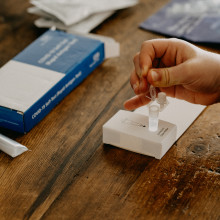
17:20 - How to fake a lateral flow test
How to fake a lateral flow test
Mark Lorch, The University of Hull
There have been reports that kids have been using soft drinks to fake their COVID tests and get out of school. In fact, you can find out how to do it on TikTok, and apparently all you need is some orange juice or cola. But is it true? And if it is true, how does it work? Eva Higginbotham spoke to Mark Lorch from the University of Hull...
Eva - Many of us are familiar with lateral flow tests by now - the small plastic COVID tests that we can do rapidly at home, but fewer of us actually know how they work - myself included. I didn't know that they even have gold in them… How much money do you think I could make if I collect all the lateral flow tests I can find and take the gold out?
Mark - Uh, pennies, probably! That's a really good question. You know what? I might have to go and do the calculation to figure out...
Eva - That's chemist Mark Lorch from the University of Hull, and when he heard reports about people faking positive lateral flow tests using various soft drinks, he took it upon himself to figure out how on earth this works. But first, here’s how lateral flow tests are supposed to work...
After swabbing the back of your throat and nose and mixing the swab with a little buffer solution, you put a drop of the solution onto the sample window, otherwise known as S window, of the test. This liquid gets pulled along this absorbent strip of material inside the test, and along the way, will be exposed to specialised antibodies. Now, your immune system makes antibodies, these protein molecules that are highly specific in what they will bind to, in reaction to foreign invaders in your body, but scientists can also engineer antibodies to bind to whatever they like, and can stick colourful chemicals onto them too. So in this case, they made some antibodies that are highly specific to the coronavirus and are bound to little nanoparticles of gold which, surprisingly, look more purple and reddish than what we think of gold. If your sample contains coronavirus particles then those colourful antibodies will bind to the virus particles. These then get stuck to a second set of antibodies halfway up the test, at the T or Test window, which is why you would see a reddish-purple line there if you’ve tested positive. There’s a third set of antibodies involved too, stuck at the C or control line - these antibodies will bind to the other antibodies used in the test, and are put there to show you that the test has worked. If you get a control line and no test line, you have a negative test. If you have a control line and a test line, you have a positive test. But there are reports of kids faking positive tests using soft drinks. I wanted to see it for myself, so got Mark to talk me through it...
Okay. So I've got myself some orange juice. Unfortunately, it's got bits in, is this going to be a problem?
Mark - I don't know actually, I've never tested this with orange juice with bits in! So this is groundbreaking science going on here. Do you get an apparently positive result on a lateral flow test if you use orange juice with bits in?
Eva - Let's find out! All right. So I'm going to squeeze a couple of drops then onto the sample window just as I would if I was taking it myself. And I haven't mixed this with the buffer solution, this is just straight-up orange juice
Mark - What's happening now then is that orange juice is wicking up the device, it's picking up the red nano-particles attached to the antibody and it's carrying on the lateral flow test
Eva - And I can see a line where the T is! And it's actually, it's getting stronger as the seconds go by. It's just past the C now, and it's getting stronger there too. So there you go!
Mark - Well, there we go, you heard it here first - orange juice with bits in does give you a fake positive lateral flow test result for COVID
Eva - Right. So what is going on? Why does this happen?
Mark - Good question. Now, the thing that I've noticed is that all of the fluids that create this fake positive result are all acidic. So colas, orange juice, and so on, all have are about pH 3 and 4, so they're quite acidic solutions. Now the antibodies have evolved to work in very different conditions, they work in your bloodstream, which is about pH 7.3, so almost neutral, and the acidity of these drinks and so on is then quite an alien environment to the antibodies. Now antibodies are proteins and proteins are really quite sensitive to the conditions around them, particularly the pH, and by putting the antibodies in acidic conditions what essentially is happening is you're starting to unfold the antibodies. So antibodies, like all proteins, are long chain-like molecules that fold up into a very well-defined shape to do their job correctly. And when you put them in acidic conditions, you cause the antibodies to unfold slightly, which essentially destroys the specificity of the antibodies for the virus instead makes them stick to all sorts of other things in the solution, most obviously the gold nanoparticles and that's what results then in that line at the T.
Eva - So there you go - it comes down to the fact that antibodies often have quite a specific pH range that they operate at, much like how the enzymes in your stomach that help breakdown food work best in an acidic environment. And what if you want to check if a positive test is real or not? Mark told me that you can let it dry out over a few hours and then add some buffer solution to the sample window. This will wick up the test and, over time, reset the pH to about neutral causing the antibodies to get back into their proper shape. If the test is fake, the T line will disappear, and you'll know to start keeping a closer eye on the orange juice in your fridge.

23:28 - Otters use 'leaky' metabolism to stay warm
Otters use 'leaky' metabolism to stay warm
Tray Wright, Texas A&M University
Sea otters are the smallest marine mammals, and so they’ve had to adapt to their cold and wet environment. They have the thickest fur of any animal, and on top of that, an incredible ability to generate body heat. It’s that second feature that recently got some American scientists interested: how are otters so good at turning the energy from their food into heat? It turns out that inside their mitochondria - the parts of their cells that generate energy - the normally-sound membranes are a little bit leaky, which lets energy get released as heat rather than, say, used to contract a muscle. Phil Sansom heard about the process - and the remarkable otters themselves - from Texas A&M University’s Tray Wright...
Tray - They're really interesting animals because they've got this really high metabolic rate. It's about three times the metabolic rate that you would expect for an animal of their size. And we think that this high metabolic rate is really because they're trying to generate heat. Being a small mammal living in cold waters, it's really challenging for them to maintain their body temperature.
Phil - When you say metabolic rate, what exactly do you mean?
Tray - Well, metabolism is really just how these animals break down fats and sugars to use them and make energy in a form that they can use. And what our research looked at is the muscle itself. Muscle makes up a big chunk of the body mass of these animals; it uses a lot of energy. So it made sense for us to look at how these animals are consuming energy in the muscle tissue.
Phil - How do you do that? Do you get an actual otter and you put it in your lab somewhere, and you feed it a bunch of stuff - or something different?
Tray - No, what we do is we actually had small pieces of muscle, and so we can test specifically how that muscle metabolises this energy. Here we found that the sea otter muscle was very good at being inefficient. It had a capacity to make a lot of heat, but if your main goal is to stay warm, that's really helpful.
Phil - I don't understand. How is inefficiency good in this situation?
Tray - Well, think of a light bulb. The old incandescent bulbs were really inefficient. They could make the same amount of light as an LED bulb, but they generated a lot of heat and used up a lot of energy to do it. That's a bad thing when it comes to your energy bill, but it's a good thing if you actually want to heat up a room. So that's what these otters are doing: they're metabolising this energy, but they're doing it inefficiently; as a by-product they're heating their body.
Phil - Do you have any idea what specific part of the metabolic process is being inefficient?
Tray - Most of that energy is derived from inside the mitochondria, and the mitochondria pump protons across a membrane. Instead of using that proton gradient to power work, they get protons leaking across the membrane.
Phil - So you're saying it's an inefficiency in this proton pumping mechanism.
Tray - Yes. That proton gradient isn't able to be used to make functional work.
Phil - And does this actually explain their high metabolic rate in the first place, or is this just how they get their heat from their metabolic rate that they already have?
Tray - Yes, this leak metabolism is able to account for this really revved up high metabolism of these animals. And one of the really interesting things for our study was that this metabolic capacity and this leak metabolism were just as high in the neonates as they were in the adults. Typically you don't think of the metabolism as developing until the muscle is really mature, but these guys seem to have a really high metabolic capacity even when they're newborns.
Phil - The other consequence, of course, is the otters must be pretty hungry little folks...
Tray - They are! Just like we talked about earlier with the light bulb, you may have a really high energy bill if you're using this inefficient means of converting energy, and these guys do. They spend about 20-50% of their day feeding and can consume up to 25% of their body mass a day.
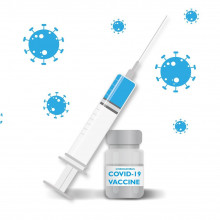
28:04 - Mailbox: COVID symptoms if you're double vaccinated
Mailbox: COVID symptoms if you're double vaccinated
It’s time for the mailbox - the part of the show where Sally Le Page and Phil Sansom respond to listener messages...
Sally - This week listener Geoff emailed us saying that he’s been double COVID jabbed, but started getting hayfever symptoms like coughing, sneezing and runny eyes. He subsequently took a couple of lateral flow tests - the first one was negative, but the later one was positive for COVID. This aligns with broadcaster Andrew Marr’s experience - he also had cold-like COVID symptoms after being doubled jabbed - so this all goes to show that if you've had both vaccine doses and you catch COVID again, the symptoms might not be the one you're expecting.
Phil - Geoff, your observation is backed up by evidence from the ZOE symptom tracker app. They say the top most common symptoms for those who’ve had both doses are now a headache, a runny nose, sneezing, a sore throat, and loss of smell. A cough and a fever are now a good way further down the list. This isn’t 100% conclusive evidence, and the symptom tracker app obviously isn’t catching everyone, but something to watch out for.
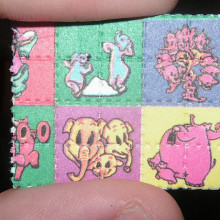
30:44 - What are psychedelic drugs?
What are psychedelic drugs?
Suzi Gage, University of Liverpool
Over the last decade, scientists have rediscovered psychedelic drugs - both as tools to research the inner workings of the brain, and as ways to treat some of the most serious mental health conditions. But what actually are psychedelics, and what do they do? University of Liverpool epidemiologist Suzi Gage is the expert - she’s the author of the book Say Why To Drugs, and explained to Phil Sansom...
Suzi - I think broadly when people talk about psychedelics, they're talking about what we refer to as the 'classical psychedelics' - these are LSD, psilocybin (which is the active compound in magic mushrooms), DMT (which is sometimes known as ayahuasca) - but there are other psychedelic substances as well. Mescaline is another one which is found in cacti. Some people say that cannabis can induce perceptual changes. Ketamine and PCP, which are dissociative anaesthetics, can induce hallucinations and things like that. Maybe even MDMA as well.
Phil - Right, that's quite a lot of drugs... why are they all linked together under this label, then, of 'psychedelic'?
Suzi - Well, the term psychedelic is thought to have been coined in the fifties by a British psychiatrist, and it's from Greek. It translates roughly as 'mind manifesting'. It became more widely used in the 60s; Timothy Leary in particular, who you've just mentioned, was a big advocate of the term. And so psychedelic substances became linked with a whole psychedelic culture, linked to music and an aesthetic as well.
Phil - What does one of these psychedelic trips actually feel like? I mean, to the best of your knowledge?
Suzi - Yeah, I mean that's a really good question, because when we think about taking a psychoactive substance, so a recreational drug... we might all understand what it feels like to be intoxicated on alcohol, and if you see someone else intoxicated on alcohol, they have quite a lot of signs that you can see what that looks like.
Phil - Sure, singing Three Lions for example.
Suzi - I was going to say, there's lots of those people on the news right now! Psychedelic intoxication is very kind of personal and inward facing. It can cause perceptual changes; people report visual hallucinations, patterns moving; synaesthesia, where two senses become connected; it can also have an emotional impact, so it can impact on how you feel about who you are; it can bring memories or feelings to the surface. But it's quite a hard thing to describe. When I wrote the book I interviewed people about their experiences; someone said, "trying to describe it is like trying to describe colour to someone who's never been able to see."
Phil - Is it a good experience or is it a bad, scary experience?
Suzi - I think it can be both - and potentially even in the same experience can be positive and negative. That's what people that I spoke to, people that I interviewed... how they described it to me is that sometimes they had quite negative experiences. One person said at one point she felt like she might've seriously damaged her mental health and she wasn't going to come back from it, which sounds absolutely terrifying. But people when I spoke to them were also at pains to say that even when they had a negative experience, they actually got quite a lot out of that after they were no longer intoxicated.
Phil - How do you mean?
Suzi - Like, understood themselves better perhaps after these experiences? I mean, some people had bad experiences and didn't enjoy it and would never do it again as well - it's important to say that.
Phil - Is that the danger of these drugs, then - that you can have that bad experience - or are they addictive as well?
Suzi - Well, they don't seem to be addictive in terms of the way we think about a substance becoming dependence-forming, let's say. So obviously you can be addicted to anything if it negatively impacts on things like your work or your home life, if you become so determined to take it regularly and it throws your life off kilter; but with quite a lot of other psychoactive substances, like think about alcohol and tobacco, these are dependence-forming. So you get a physical or mental dependence on them, as well as this potential to be addicted in the more broad sense. And psychedelics don't seem to have that at all. They also don't seem to have... or seem to be a far lower risk in terms of toxicity. If you take too much alcohol, for example, you can be very ill or it can be fatal. And that doesn't really seem to be the case with psychedelics; you'd have to take an extremely, extremely large amount, probably an impractically large amount, to experience toxicity from these substances. But as we've said, that doesn't mean that they're safe. The unpleasant effects from psychedelics are more likely to be mental than physical. Although having said that, it's also important to point out that there is the potential for injuries from behaviours undertaken while intoxicated, as is also the case for things like alcohol as well.
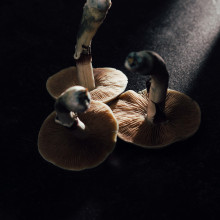
35:37 - How magic mushrooms evolved
How magic mushrooms evolved
Hannah Reynolds, Western Connecticut State University
Almost all psychedelic drugs, even if they’re synthesised in a lab, are based on products found in nature. The question then is - why does nature produce compounds that make you see colours and feel at one with the universe? That’s what an American team set out to answer when they looked into how magic mushrooms have evolved. Hannah Reynolds from Western Connecticut State University told Eva Higginbotham how they did it…
Hannah - There's actually over 200 species of magic mushrooms, and they're scattered all over the world. A lot of them aren't even very closely related to each other. And we were looking to understand - what are the genes that actually make the psychedelic compound psilocybin? And then we wanted to understand - how did these genes evolve?
Eva - And how do they make that psilocybin?
Hannah - So what they're starting with is the amino acid tryptophan. And this is what, if you eat a lot of turkey at the holidays, this is the thing that people say makes you sleepy. It's been debated whether it's just having a giant meal makes you sleepy or if it's really tryptophan... but they start with tryptophan, and then they do basically five chemical transformations, and each of the steps needs a different gene. So those were the genes that we were searching for.
Eva - And how did you go about looking for them?
Hannah - So what we did is we took six mushrooms - three were psilocybin producers, and three were not - and we did genome sequencing of all six. And then what we were looking for is: what are the genes that are shared just between the three magic mushrooms and not the others? That left us with a fairly small pool of genes, because we were ignoring the genes that were just essential for a cell to survive and to grow. And once we had that pool, we looked for the functions, and we basically found this gene cluster. And they also were close to each other on the chromosome.
Eva - How do you know that these genes that you found are the ones that make psilocybin? How can you test that?
Hannah - Great question. So what we did is take the gene sequence and then get the protein from it, and then gave it tryptophan, and it made the product that we expected. We in the United States had to stop there because of regulations that... at the time we were not allowed to create - I think they're called - class 1 drugs. But another team independently found the same genes in a different genome of mushrooms, and they were able to take these enzymes and make psilocybin from them.
Eva - And so the fact that all of these genes were clustered together in the same place of the genome of the mushroom - can we learn anything from that about how those genes might've evolved?
Hannah - Yes. In fungi, when we see that kind of pattern, sometimes that's associated with a history of horizontal gene transfer - gene jumping, if you will.
Eva - I see. So it's not like all the mushrooms across the world all independently were like, "you know what? Let's make some psilocybin." It's more like mushrooms that were next to each other shared the genes required to make psilocybin, and through that mechanism, it spread.
Hannah - Yes. So that was our final step to our paper - looking at what might those environments have been. And the environments that magic mushrooms are usually found in are dung, decaying wood, and mutualistic associations between fungi and tree roots. And it looked like the dung environment was where a lot of these exchanges might've happened.
Eva - And what is the point of these mushrooms making the psilocybin in the first place? What benefit do they get from it?
Hannah - What we think is that, in the environments where the magic mushrooms are growing, they are having to deal with insects, especially insect larvae - that are eating the decaying wood, that are eating the dung, and that maybe even are eating them, especially as they're growing through that resource before they actually make the mushroom itself. So we think that making these hallucinogenic compounds may slow down the insect enough that the mushrooms have a better chance of colonising that material, and actually growing and making a mature mushroom.
Eva - So it's about competition.
Hannah - That's our take on it.
Eva - And what does it do to an insect? If an insect eats a magic mushroom, is it going to get high? Are they like hippies?
Hannah - I think they do. What it feels like to them, I don't know, but I suspect that their brains aren't that different from ours in terms of what this does. Of course insects are living in a more smell-based world than a visual-based world. So I can only speculate, but I would think if they hallucinate, they're not so much getting visuals as maybe olfactory confusion.
Eva - That's amazing!
Hannah - That's a wild guess.
Eva - Smelling hallucinations!
Hannah - And how would I even test something like that? I have no idea. But that's what I imagine.
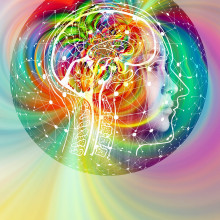
41:15 - What psychedelics do to your brain
What psychedelics do to your brain
David Nutt, Imperial College London
David Nutt is the head of Imperial College London’s Centre for Psychedelic Research. When the Centre opened in 2019 it was the world’s first dedicated institute for this kind of work - looking at how these drugs actually work in the brain, and whether the effects might be useful to treat problems with mental health. Sally Le Page asked David the former question: do we know what these drugs do to your brain?
David - We do know, because we have brain imaging techniques which have shown very clearly that these drugs have a very profound, disruptive effect on ongoing brain activity. We also know that this effect is mediated through targeting serotonin receptors. These are the proteins that serotonin works on in the brain, and there are 15 different serotonin receptors, but these hallucinogens all work on a very special one called the 5-HT2A receptor which is peculiarly dense in the human brain.
Sally - It's got a very snappy name that one. What does it do?
David - Well, there are people that think it's responsible for the evolution, the vast expansion of the human brain in recent evolution. My own view is it's latent in parts of the brain where we do our very high level thinking, looking backwards, looking forwards, where we have our dreams and our imaginations. I think it coordinates essentially the laying down of new ideas and new ways of thinking, new ways of dealing with problems, which is why in the end I think these drugs have turned out to be useful in conditions like mental illness and depression.
Sally - So when we take these drugs, what does it do to our overall brain if it's affecting these single little receptors?
David - The high level parts of your cortex, the thinking parts, the parts which integrate your hearing, your sight, your touch, etcetera - they get disrupted by psychedelics. Psychedelics, in a very simple way, put you back to what your brain was like when you were a child, when all kinds of connections were possible. The process of neur development is not a growing of the brain; it's a shrinking of the brain, getting rid of connections which you don't want. Over the decades from childhood, the brain becomes more and more constricted in what it does and more and more rigid, and psychedelics disrupt that and put you back transiently into that state of childhood wonder.
Sally - So growing up is like doing topiary on your brain, and then taking these psychedelics is letting the brain - the plant - just grow wild again, so you can kind of start from scratch.
David - Yeah, that's right. It's a kind of reset. A lot of our patients describe the influence of psilocybin treatment as being like a defrag of a hard drive, or a reformatting. It allows people to break out of ways of thinking. Often depressed people, for instance, get locked into thinking the same thought time and time again. "I made a mistake, I shouldn't have done this, I was a bad person." They can't escape that thinking because our brains are extraordinarily efficient at learning to do things, but if they learn to do the wrong thing and have the wrong thought, they're very hard to disrupt. And psychedelics are probably the most powerful way of disrupting that kind of unwanted thinking.
Sally - Does this disruption explain the other side effects we see - like the hallucinations, and feeling at one with the universe?
David - Absolutely. Now that's what we discovered first. The reason we started treating depressed people with psilocybin was because we saw that the ability of psilocybin to disrupt the networks of the brain which contained thinking is the same as its ability to disrupt the networks which control vision, and sense of self, and position and place in the universe. So visual hallucinations, they're really remarkable, because under psychedelics your visual cortex temporarily is unable to properly reconstruct the signals in the eye into images, and those simple hallucinations - we know from sophisticated electrophysiological experiments - those are the very early ways in which you reconstruct what you see. So under psychedelics, you actually see the primary workings of your visual cortex, which is actually, I think, extraordinarily interesting and something which you haven't experienced since you were a child.
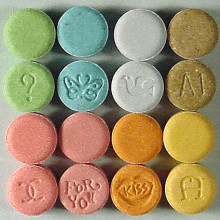
45:38 - MDMA used to treat addiction
MDMA used to treat addiction
Ben Sessa, Awakn Life Sciences
In Bristol, a company called Awakn Life Sciences is trialling the use of MDMA to treat addiction. MDMA isn’t a classical psychedelic drug - in fact, as a rave drug it’s also known as ecstasy - but as psychiatrist Ben Sessa told Phil Sansom, in the clinic it has some very useful psychedelic properties...
Ben - It has an amazing capacity to induce a state of empathy, and to turn off the fear response. Now this is very important with people who have trauma related disorders, particularly addictions, post-traumatic stress disorder... it's very difficult for people to do therapy with these disorders because the trauma is so intense. They can't recall the painful memories without wishing to flee and end the treatment. MDMA has a remarkable quality to turn off the fear, and allow you this brief few hours in which to carry out trauma-focused psychotherapy.
Phil - Interesting. So you can still remember what you're thinking about, but you don't feel afraid.
Ben - Absolutely. It's quite pharmacologically unique, MDMA, in that it just turns off the fear response whilst leaving the other faculties intact.
Phil - Based on the study that you've done - how well does it actually work?
Ben - It was what we call an open-label pilot study, and we need to do some randomised control studies to further that research, but the outcomes were very positive indeed. With the control group around 75% of people at nine months had returned to pre-detox levels of drinking, compared to just 20% in those that underwent our MDMA therapy.
Phil - That does sound like a big change. What's the link though between trauma, which MDMA is helping people access, and alcoholism?
Ben - There so often is trauma, particularly childhood trauma, abuse, and maltreatment, that emerges very early in life and causes disruption to a person's attachment relationship. Now the attachment relationship is the blueprint for our psychological functioning throughout life. It's very well-known that damage to attachment relationships is associated with most, if not all, chronic mental disorders. So it's no surprise that those patients who become addicted to drugs of all kinds so often have these difficult childhoods and poor attachment relationships.
Phil - So is it as simple in your studies as, you give people a pill and then they feel better? Because I think people are quite wary about the idea that you can solve a mental health problem that's got so many different causes with a single drug.
Ben - Absolutely. I think the interesting thing about psychedelic research in general is this is the antithesis of the way we currently use drugs in psychiatry. Most mental health medications one takes on a daily basis for weeks, months, decades, in order to mask symptoms. The interesting thing about psychedelic-assisted psychotherapy is you only need to take the drug on a few occasions mixed with psychotherapy, and that's where it really works.
Phil - Oh, so it's 'talk talk talk talk', 'drug', 'talk talk talk talk talk'.
Ben - Yes, the bulk of the work is done in the non-drug post integration sessions.
Phil - You rarely get a one size fits all medicine in the field. So how many people does this actually seem to work for?
Ben - Well the results of psychedelic research of the last 15 years have been staggeringly good for a range of different compounds - psilocybin, ketamine, MDMA - across a wide range of psychiatric disorders including addictions, anxiety disorders, depression. So it remains to be seen how well psychedelics could be used in psychiatry, but so far the results suggest that the applications could be very wide indeed across multiple disorders. Indeed, we may one day look back and think, "why did we ever do psychotherapy without drug assistance with psychedelics?"
Phil - You really think it's that big of a deal?
Ben - We have to be very careful not to get ahead of ourselves here. One of the reasons this research died in the 60s was because there was too much of a messianic approach that these drugs were panaceas. They're not panaceas. Mental health is complex. There's psychological factors, social factors, as well as biological and genetic factors. But it certainly seems looking at the results of the last 15 years that the results are extremely good indeed.
Phil - Where do you think this is going then Ben? Am I going to be able to go to my GP and they prescribe me some MDMA?
Ben - If the research continues at the pace it's going, then we should see MDMA approved as a drug to treat trauma-based disorders in around 2023. Psilocybin, a couple of years after that. Ketamine is already available for the treatment of these disorders. One of the big goals we have is to make sure that this appears on the public health service. It's no good if it's just confined to private medicine. So we need to work with the regulatory authorities and with the funding authorities to make sure that this is free, public access healthcare for everyone.

50:53 - The future of psychedelic research
The future of psychedelic research
David Nutt, Imperial College London
David Nutt told Phil Sansom and Sally Le Page about his research using psychedelic drugs to treat mental disorders...
David - So, our primary target has been depression. We've done two trials of psilocybin in depression. The first showed it was the most powerful treatment ever for resistant depression that a single trip produced 50% reductions in depression scores within a day. Many found quite long lasting benefits. A few of those people from that first trial are well eight years later, and then we went on to compare it with a conventional antidepressant, an SSRI called escitalopram, and again we found it worked on a range of symptoms better than the SSRI. So, now we're moving to other disorders. Currently in Imperial we're doing a study in anorexia and we're setting up a study in obsessive compulsive disorder. You might say, 'well, what they got to do with depression?' The answer is that those three disorders are all what we call internalising disorders. They're all disorders where people get locked into thinking ways of thinking that they don't want to be locked into, but they can't escape. We think that psychedelics might have the power to break down that over-learned that sort of repetitive stereotype thinking.
Phil - 50% reduction in depression scores is a big claim. Can you be absolutely sure that that's not some sort of extra placebo that they get from the actual trip itself?
David - Well, that's clearly a placebo effect of being involved in intensive research treatments, but comparing it with the best antidepressant we've got, which is what we've just done, one of the best antidepressants, and shown and we get significant benefit over and above that, convinces me that this is actually a very powerful, it's more powerful probably than any other treatment we've had.
Phil - Does it last?
David - Well, for some people it does, but for others, it doesn't. This is the big challenge for now, the real research direction is to see how we can maintain the effect. It may be we have to give top-up treatments maybe two or three times a year or it might be we want to do something else. We want to get people well, and then keep them well, perhaps with a traditional antidepressant or some other kinds of psychotherapy. That's where the real research challenges over the next few years.
Sally - So, David, are you suggesting that people with depression go out and take LSD, pop some magic mushrooms?
David - Definitely not. No, because we know that when people with depression have a psychedelic experience, it's generally not pleasant. It's challenging. They often go back to the traumas, which led them to be depressed in the first place. We really don't recommend self medication because you could have a bad trip, which could be very distressing. Our trips obviously always looked out, you know, people who was looked after by therapists, but beyond that, we think there's a real benefit for having the therapist there the next day for what we call the integration session. That's when people talk about the experience, tell the therapist what they saw and the therapist then helps them make sense of their illness, but more importantly, helps them develop ways to recover from the depressive thinking.

54:12 - QotW: Why is it cold up mountains?
QotW: Why is it cold up mountains?
Sally Le Page reached out to atmospheric physicist Simon Clark for the answer...
Simon - Hot air rises because it's warmer than surrounding air yet under the same atmospheric pressure. Air pressure and temperature are connected via some rules that describe how all gases behave. Specifically, a pocket of air at the Earth's surface that's warmer than its surroundings must be less dense than its surroundings, and so, like a bubble of less dense air in a swimming pool of very dense water, it rises above the surrounding air.
Sally - I see, heat rises at ground level because it is less dense than the air around it. But Wayne is right, it is much colder up in the mountaintops. What is different at high altitudes?
Simon - To make things more complicated, however, as air rises in the atmosphere, it also cools. This is because as it rises it is subject to less and less atmospheric pressure. Atmospheric pressure is just the weight of air above pushing down on you, and so the higher you go in the atmosphere, the less pressure you experience.
Sally - And what effect does there being less pressure pushing down on me (pushing down on you) have on hot air?
Simon - As a bundle of warm air rises through the atmosphere, there is less and less air above pushing down on it. This release of pressure allows the air parcel to expand and, in the process, cool down. The higher a pocket of air rises, the cooler it becomes. Generally a parcel of warm air will only rise so far before stopping, having cooled to the point where it is the same temperature as its new surroundings. This means it's the same density as its surroundings, and so has no motivation to rise any further. This process, known as adiabatic cooling, combined with the fact that the atmosphere is heated from below by the Earth, means that the atmosphere gets colder as you get higher and higher, and hence why mountaintops are cold.
Sally - So that solves it. Hot air rises because it is less dense than cold air, but the higher up it goes, the more it cools down leading to snow-capped mountains. Next week’s question might be a little more hairy, as Beth asked:
Beth - “My dog is always licking her fur but never gets hairballs. Why don’t dogs get hairballs?”
Related Content
- Previous Wally Funk Heads for Space
- Next The uterus and placenta










Comments
Add a comment